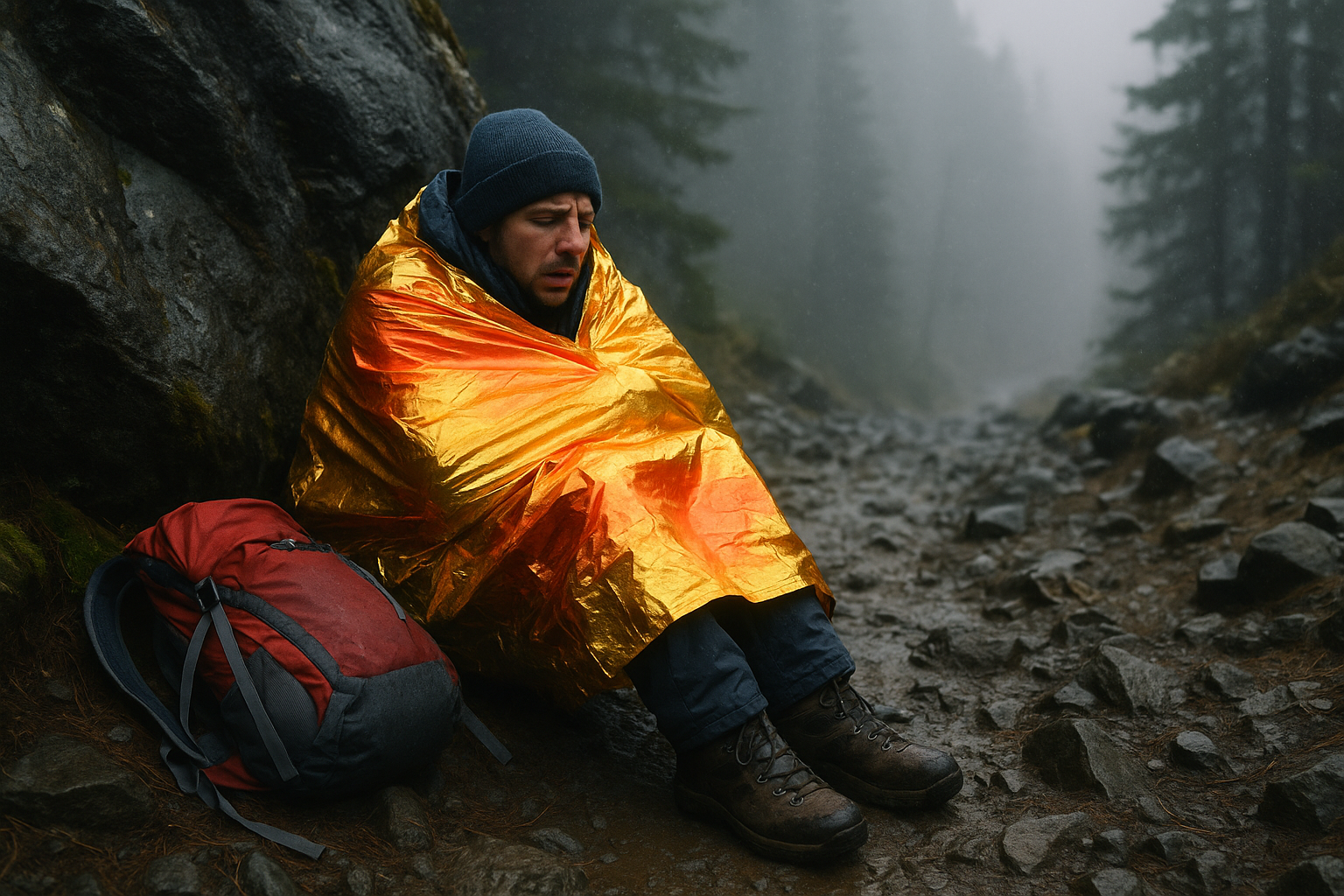The Cold Isn’t Just Chilling—It’s Deadly
You’re hours into a day-trek. The sky shifts, temperatures plunge, and rain pelts down. Your clothes are soaked, the wind cuts through you, and suddenly you’re shivering uncontrollably. This isn’t discomfort. It’s hypothermia—an emergency that can kill in hours.
When fire isn’t an option—whether due to wet conditions, high winds, or lack of fuel—your survival depends on ingenious thermal gear that heats you fast, without an open flame.
1️⃣ Self-Heating Emergency Blankets and Bivvies
Forget the crinkly Mylar blankets that only reflect heat. Upgrade to self-heating survival gear:
- HotHands Heated Emergency Blanket (Amazon): Infused with heat packs, this blanket generates warmth for hours, even in freezing rain.
- SOL Escape Bivvy with Heat Reflective Layer (Amazon): Breathable, moisture-resistant, and significantly warmer than standard space blankets. Doubles as a wind barrier and retains 90% of body heat.
- DIY Emergency Bivvy: Line a regular space blanket with chemical heat packs inside a trash bag to create a fast-insulating cocoon.
🔥 Field Tip: Always pack a self-heating blanket or bivvy in your emergency kit—compact and under a pound, it could save your life.
2️⃣ Chemical Heat Packs and Body Warmers
- HotHands or Grabber Hand Warmers (Amazon): Small, lightweight, and air-activated. Place in gloves, pockets, boots, or layered under clothes for direct heat.
- Adhesive Body Warmers: Stick directly onto base layers at the core (chest, lower back) for targeted warmth.
- Improvised Heat Pack: Carry iron powder-based hand warmers. Activated with oxygen, they provide reliable heat even in damp environments.
🎒 Advanced Trekker Tip: Store chemical warmers in a ziplock with a desiccant pack to extend shelf life and prevent accidental activation.
3️⃣ Insulated, Windproof Shells
Layering isn’t just about bulk—it’s about blocking wind and trapping body heat. Essential gear includes:
- Outdoor Research Helium AscentShell (Amazon): A breathable, waterproof, windproof shell that seals in warmth and keeps out moisture.
- Ultralight Packable Down Jackets (like Mountain Hardwear Ghost Whisperer, Amazon): Compressible and highly insulating, even when damp.
- Improvised Shell: In a pinch, use a plastic poncho, trash bag, or emergency tarp to create a windproof barrier.
💡 Pro Move: Wear windproof layers over your insulating layers. This traps warm air and prevents evaporative cooling.
4️⃣ Heat-Reflective Ground Barriers
The ground steals body heat faster than air. Prevent conduction loss with:
- SOL Thermolite Sleeping Pad (Amazon): Reflective barrier under your body to bounce heat back.
- Closed-Cell Foam Pads: Lightweight, effective insulation against wet and cold ground.
- DIY Ground Barrier: Lay down a thick layer of dry leaves, pine needles, or even your empty pack to insulate from below.
🧠 Field Wisdom: Never sit or lie directly on cold ground—use whatever you have to create a buffer.
5️⃣ Compact, Battery-Operated Heating Gear
For high-tech trekkers, consider USB-rechargeable heating gear:
- Heated Gloves and Insoles (like Savior Heat, Amazon): Built-in heating elements powered by compact batteries. Perfect for extremity warming.
- Battery-Operated Heated Vests (like Ororo, Amazon): Lightweight, core-heating gear that runs for hours on a single charge.
- Power Bank Charger: Keep an emergency charger (like Anker PowerCore) to recharge heating gear in the field.
⚠️ Note: Always check battery charge levels before a trek. Cold drains batteries faster.
6️⃣ Improvised Thermal Boosts Without Fire
If you’re caught unprepared, these field hacks can buy you precious warmth:
- Stuff Clothes with Dry Debris: Pack your clothes with dry leaves, moss, or grass for extra insulation.
- Body-to-Body Warmth: Share body heat by huddling with a companion inside a shelter or emergency bivvy.
- Layer Plastic Bags: Trap warm air between layers using grocery or trash bags over socks and gloves.
- Move Strategically: Gentle, controlled movement can generate heat—avoid violent shivering or overexertion, which can accelerate heat loss.
7️⃣ Stealth Survival in Hypothermia Scenarios
If your survival scenario demands low visibility—whether due to human threats or wildlife—opt for:
- Matte-Finish, Earth-Tone Gear: Choose gear in green, brown, or black to blend into the environment.
- Silent Gear Deployment: Avoid crinkly Mylar or loud, reflective gear. Practice unfolding blankets and opening packs quietly.
- Minimal Light Use: If you must signal or check gear, use red-light headlamps angled downward.
🌲 Pro Field Hack: Wrap reflective or shiny surfaces with duct tape or cloth to reduce glare.
8️⃣ Field-Tested Trekker’s Story
“During a winter trek in the Rockies, a surprise storm hit. With no fire-starting tools and temperatures plummeting, I relied on a SOL Escape bivvy and chemical heat packs from my emergency kit. They bought me enough time to reach a trailhead. I now pack extras every trip.”
Conclusion: Fire Isn’t Your Only Lifeline
When hypothermia strikes, and you can’t build a fire, preparation and ingenuity are your survival keys. Self-heating blankets, chemical warmers, battery-powered gear, and strategic layering keep your core temperature up long enough to escape or signal for help.
Don’t wait for rescue—carry thermal gear that makes fire optional.

